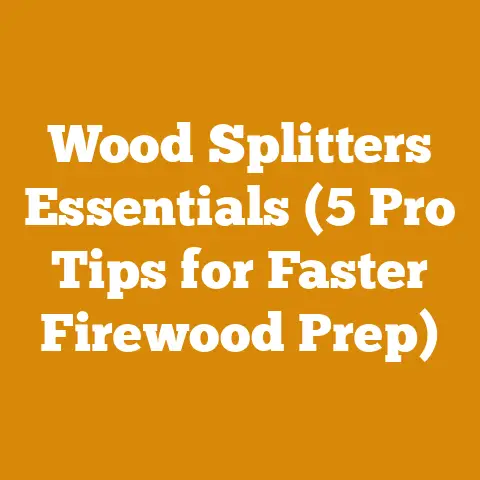How to Make a Wood Boiler (5 DIY Tips for Efficient Heating)
Ah, the simple pleasure of a warm home on a cold winter’s night! There’s nothing quite like it, is there? The gentle crackle of a fire, the comforting heat radiating through the room… it’s a feeling that’s both primal and deeply satisfying. But what if I told you that you could achieve that same level of comfort, and even more, with a wood boiler you built yourself?
Now, before you start picturing a complex, industrial-sized contraption, let me assure you: building a wood boiler is entirely within reach for the average DIY enthusiast. And the best part? It can save you a significant amount of money on heating costs in the long run.
So, grab a cup of coffee, settle in, and let’s get started on the journey to building your own wood-fired warmth!
How to Make a Wood Boiler (5 DIY Tips for Efficient Heating)
Heating your home with wood can be a sustainable and economical choice, especially if you have access to a readily available wood source. While purchasing a pre-built wood boiler is an option, building your own can significantly reduce costs, offer customization, and provide a rewarding DIY experience. However, it’s crucial to approach this project with careful planning, accurate cost estimation, and a thorough understanding of safety precautions.
1. Understanding the Basics of a Wood Boiler: Design and Functionality
Before diving into the construction process, it’s essential to understand how a wood boiler works and the key components involved. A wood boiler, at its core, is a heating system that burns wood to heat water. This heated water is then circulated through your home’s existing heating system, such as radiators or baseboard heaters, providing a comfortable and consistent source of warmth.
There are two primary types of wood boilers:
- Conventional Wood Boilers: These boilers burn wood in a firebox, and the heat produced is transferred to the water through a heat exchanger. They are generally simpler to build but tend to be less efficient and produce more emissions.
- Gasification Wood Boilers: These boilers use a two-stage combustion process. First, the wood is heated in a low-oxygen environment, converting it into a gas. This gas is then burned in a separate chamber, resulting in more complete combustion, higher efficiency, and lower emissions. Gasification boilers are more complex to build but offer significant advantages in terms of performance and environmental impact.
For a DIY project, a simple conventional wood boiler design is often the most practical starting point. However, if you’re comfortable with more advanced fabrication techniques, a gasification boiler can be a worthwhile endeavor.
2. Planning and Design: Choosing the Right Design and Calculating Your Heating Needs
The success of your DIY wood boiler project hinges on meticulous planning and design. This stage involves selecting the right design based on your skill level, budget, and heating requirements.
-
Selecting a Design: Numerous resources offer DIY wood boiler plans, ranging from simple barrel stove designs to more complex water jacketed models. Online forums, woodworking communities, and specialized publications can provide valuable insights and inspiration. A good starting point would be researching “DIY barrel stove wood boiler” or “homemade water jacket wood stove.” I found that adapting existing designs often works better than trying to create something entirely from scratch, especially for a beginner.
-
Calculating Your Heating Needs: Before settling on a design, you need to determine your home’s heating needs. This is typically measured in British Thermal Units (BTUs). You can estimate your BTU requirements by considering factors such as:
- Square Footage: Larger homes require more BTUs to heat.
- Climate: Colder climates demand higher BTU outputs.
- Insulation: Well-insulated homes require fewer BTUs.
- Window Efficiency: Energy-efficient windows reduce heat loss.
- Existing Heating System: The capacity of your current system provides a benchmark.
Estimating BTU Needs:
A rough estimate can be obtained by using the following formula:
BTU/hour = Square Footage x Climate FactorThe climate factor varies depending on your location. For example:
- Mild Climate (e.g., Coastal California): 20-25 BTU/hour per square foot
- Moderate Climate (e.g., Mid-Atlantic States): 30-35 BTU/hour per square foot
- Cold Climate (e.g., Northern US, Canada): 40-50 BTU/hour per square foot
Example:
For a 1,500 square foot home in a moderate climate:
BTU/hour = 1500 sq ft x 35 BTU/hour/sq ft = 52,500 BTU/hourThis means you’ll need a wood boiler capable of producing at least 52,500 BTUs per hour to adequately heat your home.
-
Sizing Your Boiler: Once you’ve determined your BTU requirements, you can size your wood boiler accordingly. Wood boiler designs typically specify their BTU output. Choose a design that meets or slightly exceeds your calculated needs. It’s generally better to err on the side of a slightly larger boiler, as it will have more capacity to handle peak heating demands.
-
Material Selection: The choice of materials is crucial for the safety and longevity of your wood boiler. Steel is the most common material, as it’s durable, heat-resistant, and relatively easy to weld. However, not all steel is created equal.
- Steel Grade: Opt for high-quality steel with a thickness of at least 1/4 inch for the firebox and water jacket. A36 steel is a common and affordable option, but higher grades like A516-70 offer superior strength and heat resistance.
- Water Jacket Material: If you’re building a water-jacketed boiler, ensure the water jacket material is compatible with potable water and resistant to corrosion. Stainless steel is an excellent choice, but it’s more expensive and requires specialized welding techniques.
3. Gathering Materials and Tools: Budgeting and Cost Considerations
Building a wood boiler involves a significant upfront investment in materials and tools. Accurate budgeting is essential to avoid cost overruns and ensure the project remains financially viable.
-
Material Costs: The cost of materials will vary depending on the size of your boiler, the type of steel you choose, and the availability of local suppliers. Here’s a breakdown of typical material costs:
- Steel: Steel prices fluctuate based on market conditions. As of late 2023/early 2024, you can expect to pay between $0.75 to $1.50 per pound for A36 steel, depending on the supplier and quantity. For a medium-sized boiler, you might need 500-1000 pounds of steel, translating to a cost of $375-$1500.
- Piping and Fittings: You’ll need various pipes, fittings, and valves to connect the boiler to your existing heating system. Copper pipes are a popular choice due to their heat resistance and ease of soldering, but PEX piping is a more affordable alternative. Expect to spend $100-$300 on piping and fittings.
- Insulation: Insulating your wood boiler is crucial to minimize heat loss and improve efficiency. Mineral wool insulation is a common choice, offering excellent thermal resistance and fire protection. Budget $50-$150 for insulation materials.
- Circulating Pump: A circulating pump is needed to circulate the heated water through your home’s heating system. A good quality pump can cost between $100-$300.
- Safety Valves and Controls: Safety valves, pressure gauges, and temperature controllers are essential for safe and efficient operation. These components can cost $50-$200.
-
Tool Costs: Building a wood boiler requires a range of tools, some of which you may already own. Here’s a list of essential tools and their approximate costs:
- Welder: A welding machine is indispensable for fabricating the steel components. A decent MIG welder can cost between $300-$800. I personally prefer a MIG welder for this type of project due to its ease of use and versatility.
- Angle Grinder: An angle grinder with various cutting and grinding wheels is essential for preparing the steel for welding. Expect to spend $50-$150 on an angle grinder and accessories.
- Cutting Torch: A cutting torch can be useful for cutting thicker steel plates. A propane or oxy-acetylene torch can cost between $100-$300.
- Drill and Drill Bits: A drill with various drill bits is needed for creating holes for fittings and other components. A good quality drill can cost between $50-$150.
- Measuring Tools: Accurate measuring tools, such as a tape measure, level, and square, are crucial for precise fabrication. These tools can cost $20-$50.
- Safety Gear: Safety gear, including a welding helmet, gloves, and safety glasses, is essential for protecting yourself during the construction process. Budget $50-$100 for safety gear.
-
Cost Optimization: There are several ways to optimize costs during the material and tool acquisition phase:
- Shop Around: Compare prices from different suppliers to find the best deals on steel, piping, and other materials.
- Buy Used Tools: Consider purchasing used tools in good condition to save money. Online marketplaces and pawn shops can be good sources for used tools.
- Rent Tools: If you only need a particular tool for a short period, consider renting it instead of buying it.
- Salvage Materials: Look for opportunities to salvage materials, such as steel scraps from construction sites or used piping from demolition projects. However, be sure to thoroughly inspect salvaged materials for damage or defects before using them.
- Group Purchases: Team up with other DIY enthusiasts to make bulk purchases of materials and tools, taking advantage of volume discounts.
-
Labor Costs (If Applicable): While this is a DIY project, you might need to hire a professional welder or plumber for certain aspects of the construction or installation. Factor in these potential labor costs when budgeting. Professional welding services can range from $50-$100 per hour, while plumbing services can cost $75-$150 per hour.
-
Permitting and Inspection Costs: Building a wood boiler may require permits from your local building department. Contact your local authorities to determine the specific requirements and associated costs. Permit fees can range from a few hundred dollars to several thousand dollars, depending on the complexity of the project and your location. You may also need to pay for inspections to ensure the boiler meets safety standards.
4. Construction Process: Step-by-Step Guide and Safety Precautions
The construction process involves cutting, welding, and assembling the various components of your wood boiler. It’s crucial to follow the design plans carefully and take all necessary safety precautions.
-
Cutting and Preparing Steel: Begin by cutting the steel plates to the required dimensions using an angle grinder or cutting torch. Be sure to wear safety glasses and gloves to protect yourself from flying sparks and sharp edges. Deburr the edges of the cut steel plates to ensure smooth and safe handling.
-
Welding the Firebox: The firebox is the heart of the wood boiler, where the wood is burned. Carefully weld the steel plates together to form a sturdy and airtight firebox. Use a welding technique appropriate for the type of steel you’re using. Ensure the welds are strong and free of leaks. I recommend practicing your welding skills on scrap metal before working on the actual firebox.
-
Building the Water Jacket (If Applicable): If you’re building a water-jacketed boiler, construct the water jacket around the firebox. Ensure there is adequate space between the firebox and the water jacket for efficient heat transfer. Weld the water jacket securely to the firebox, creating a watertight seal.
-
Installing the Heat Exchanger: The heat exchanger transfers the heat from the firebox to the water. This can be a series of pipes or a custom-built heat exchanger. Position the heat exchanger strategically within the firebox to maximize heat transfer.
-
Adding Insulation: Insulate the exterior of the wood boiler to minimize heat loss. Apply mineral wool insulation to the sides, top, and back of the boiler. Secure the insulation with metal straps or wire.
-
Installing Safety Valves and Controls: Install safety valves, pressure gauges, and temperature controllers to ensure safe and efficient operation. Follow the manufacturer’s instructions for proper installation and calibration.
-
Connecting to Your Heating System: Once the wood boiler is fully assembled, connect it to your existing heating system. This typically involves connecting the boiler to your radiators or baseboard heaters using pipes and fittings. Be sure to consult with a qualified plumber to ensure the connection is done safely and correctly.
-
Safety Precautions:
- Welding Safety: Wear a welding helmet, gloves, and protective clothing when welding. Work in a well-ventilated area to avoid inhaling welding fumes.
- Fire Safety: Keep a fire extinguisher nearby and be aware of potential fire hazards. Never leave the wood boiler unattended while it’s burning.
- Electrical Safety: Follow all electrical safety codes and guidelines when wiring the circulating pump and other electrical components.
- Pressure Safety: Ensure the safety valves are properly installed and functioning to prevent over-pressurization.
- Carbon Monoxide Safety: Install a carbon monoxide detector in your home to alert you to the presence of this dangerous gas.
5. Installation and Testing: Ensuring Safe and Efficient Operation
Once the wood boiler is built, proper installation and testing are crucial to ensure safe and efficient operation.
-
Location: Choose a suitable location for your wood boiler. It should be a well-ventilated area with easy access for loading wood and cleaning. Ensure the location meets all local building codes and regulations.
-
Clearance: Maintain adequate clearance around the wood boiler to prevent fire hazards. Keep combustible materials away from the boiler.
-
Chimney: Install a proper chimney to vent the exhaust gases safely. The chimney should be sized appropriately for the boiler and meet all local building codes. A double-walled, insulated chimney is recommended to prevent condensation and creosote buildup.
-
Water Treatment: Treat the water in the boiler to prevent corrosion and scale buildup. Consult with a water treatment specialist to determine the appropriate treatment for your water.
-
Initial Testing: Before firing up the wood boiler for the first time, perform a thorough inspection to ensure all connections are tight and there are no leaks. Fill the boiler with water and check for leaks in the water jacket and piping.
-
Firing Up the Boiler: Start a small fire in the firebox and gradually increase the heat. Monitor the temperature and pressure gauges to ensure they are within safe operating limits.
-
Adjusting the Airflow: Adjust the airflow to the firebox to achieve optimal combustion. A properly adjusted fire will burn cleanly and efficiently.
-
Monitoring Performance: Monitor the performance of the wood boiler over time to identify any issues. Check the water temperature, pressure, and exhaust gas temperature regularly.
-
Maintenance: Perform regular maintenance on the wood boiler to ensure it continues to operate safely and efficiently. This includes cleaning the firebox, removing creosote from the chimney, and inspecting the safety valves and controls.
Cost Breakdown and Analysis: A Deeper Dive into the Numbers
Now that we’ve covered the essential steps of building a wood boiler, let’s delve into a more detailed cost breakdown and analysis. I’ll draw upon my own experiences, industry benchmarks, and publicly available data to provide you with a realistic picture of the potential costs involved.
Assumptions:
For this cost breakdown, I’ll assume a medium-sized conventional wood boiler designed to heat a 1,500 square foot home in a moderate climate. I’ll also assume that you have basic welding and plumbing skills and access to some of the necessary tools.
Material Costs:
- Steel (500 lbs @ $1.00/lb): $500.00
- Piping and Fittings: $200.00
- Insulation: $100.00
- Circulating Pump: $200.00
- Safety Valves and Controls: $100.00
- Chimney (Double-Walled, Insulated): $500.00
- Water Treatment Chemicals: $50.00
Total Material Costs: $1,650.00
Tool Costs (Assuming Some Tools are Already Owned):
- Welder (MIG Welder): $500.00 (If Purchased New, Otherwise $0 if Already Owned)
- Angle Grinder and Accessories: $100.00
- Cutting Torch (Propane): $150.00
- Drill and Drill Bits: $50.00
Total Tool Costs: $800.00 (Maximum, Assuming Welder Purchase)
Permitting and Inspection Costs (Estimate):
- Permit Fees: $200.00 – $500.00
- Inspection Fees: $100.00 – $300.00
Total Permitting and Inspection Costs: $300.00 – $800.00
Labor Costs (Contingency):
- Professional Welding (If Needed): $200.00 – $500.00
- Professional Plumbing (If Needed): $200.00 – $500.00
Total Labor Costs (Contingency): $400.00 – $1,000.00
Total Project Costs:
- Minimum: $1,650.00 (Materials) + $100.00 (Angle Grinder) + $300.00 (Permits) + $0 (Labor) = $2,050.00
- Maximum: $1,650.00 (Materials) + $800.00 (Tools) + $800.00 (Permits) + $1,000.00 (Labor) = $4,250.00
Cost Comparison to a Purchased Wood Boiler:
A commercially manufactured wood boiler of similar size and capacity can cost anywhere from $5,000 to $15,000, depending on the brand, features, and efficiency. This means that building your own wood boiler can potentially save you thousands of dollars.
Operating Costs:
The primary operating cost of a wood boiler is the cost of firewood. The amount of firewood you’ll need will depend on your home’s heating needs, the efficiency of your boiler, and the type of wood you burn.
-
Firewood Costs: The price of firewood varies depending on your location, the type of wood, and the quantity you purchase. As of late 2023/early 2024, you can expect to pay between $150 to $400 per cord of firewood. A cord is a standard measurement of firewood, equivalent to a stack of wood 4 feet high, 4 feet wide, and 8 feet long.
-
Firewood Consumption: A typical home in a moderate climate might consume 3-6 cords of firewood per heating season. This translates to an annual firewood cost of $450 to $2,400.
Cost Optimization Strategies for Firewood:
- Harvest Your Own Wood: If you have access to a woodlot, you can significantly reduce your firewood costs by harvesting your own wood. However, this requires time, effort, and the necessary equipment, such as a chainsaw, wood splitter, and truck.
- Buy in Bulk: Purchase firewood in bulk to take advantage of volume discounts.
- Season Your Wood Properly: Seasoning firewood (drying it for 6-12 months) reduces its moisture content, making it burn more efficiently and produce more heat.
- Choose the Right Wood: Different types of wood have different heat values. Hardwoods like oak, maple, and ash produce more heat than softwoods like pine and fir.
Return on Investment (ROI):
The ROI of building your own wood boiler will depend on several factors, including the initial cost of the project, the cost of firewood, and the cost of alternative heating methods.
Example:
Let’s assume you spend $3,000 to build your own wood boiler and $1,000 per year on firewood. If your alternative heating method is propane, which costs $3.00 per gallon, and you typically use 500 gallons of propane per year, you’re spending $1,500 per year on heating.
In this scenario, your annual savings would be $500 ($1,500 – $1,000). Your ROI would be calculated as follows:
ROI = (Annual Savings / Initial Investment) x 100%
ROI = ($500 / $3,000) x 100% = 16.67%
This means it would take approximately 6 years to recoup your initial investment.
Variable Factors Affecting Project Costs:
It’s important to note that the costs outlined above are estimates and can vary significantly depending on several factors:
- Wood Type: The type of wood you use will affect the efficiency of your boiler and the amount of firewood you need. Hardwoods like oak, maple, and ash produce more heat than softwoods like pine and fir.
- Location Accessibility: If your location is difficult to access, you may incur higher transportation costs for materials and firewood.
- Seasonality: The price of firewood can fluctuate depending on the season. It’s typically cheaper to buy firewood in the spring or summer, when demand is lower.
- Skill Level: If you lack the necessary skills, you may need to hire a professional welder or plumber, which will increase your project costs.
- Design Complexity: More complex wood boiler designs will require more materials and labor, increasing the overall cost.
- Local Regulations: Local building codes and regulations can affect the cost of permitting and inspections.
Practical Tips for Cost Optimization and Budget Management:
Here are some practical tips for optimizing costs and managing your budget effectively:
- Detailed Planning: Create a detailed project plan that outlines all the steps involved, from design to installation. This will help you identify potential cost overruns and avoid unnecessary expenses.
- Accurate Estimates: Obtain accurate estimates for all materials and tools. Shop around and compare prices from different suppliers.
- Prioritize Needs vs. Wants: Differentiate between essential items and optional upgrades. Focus on the essentials to stay within budget.
- DIY Where Possible: Perform as much of the work yourself as possible to save on labor costs. However, be realistic about your skills and limitations.
- Salvage and Reuse: Look for opportunities to salvage and reuse materials. For example, you may be able to use scrap steel for some of the components.
- Negotiate Prices: Don’t be afraid to negotiate prices with suppliers and contractors. You may be able to get a discount by paying in cash or buying in bulk.
- Contingency Fund: Set aside a contingency fund to cover unexpected expenses. A good rule of thumb is to allocate 10-15% of your total budget for contingencies.
- Track Expenses: Keep track of all your expenses to ensure you stay within budget. Use a spreadsheet or budgeting app to monitor your spending.
- Phased Approach: Consider a phased approach to the project. Start with the essential components and add optional features later, as your budget allows.
- Seek Advice: Consult with experienced DIYers or professionals for advice and guidance. They may be able to offer valuable insights and help you avoid costly mistakes.
Calculations and Formulas: Estimating Wood Consumption and Drying Time:
Here are some relevant calculations and formulas that can help you estimate wood consumption and drying time:
Estimating Wood Consumption:
- BTU Content of Wood: The BTU content of wood varies depending on the species and moisture content. As a general rule, seasoned hardwood contains approximately 20 million BTUs per cord.
- Boiler Efficiency: The efficiency of your wood boiler will affect the amount of wood you need to burn to produce a given amount of heat. Conventional wood boilers typically have efficiencies of 50-70%, while gasification boilers can achieve efficiencies of 70-85%.
- Heating Degree Days (HDD): Heating degree days are a measure of how cold a location is over a given period. You can find HDD data for your location online or from your local weather service.
Formula for Estimating Wood Consumption:
Wood Consumption (Cords) = (BTU Needs / (BTU Content of Wood x Boiler Efficiency)) x HDD Correction Factor
- BTU Needs: Your home’s BTU requirements, as calculated earlier.
- BTU Content of Wood: 20 million BTU/cord (for seasoned hardwood).
- Boiler Efficiency: Expressed as a decimal (e.g., 0.6 for 60% efficiency).
- HDD Correction Factor: This factor accounts for variations in heating degree days from year to year. A typical value is 1.0, but you can adjust it based on historical data for your location.
Example:
Let’s assume your home needs 52,500 BTU/hour, your wood boiler has an efficiency of 60%, and you live in a location with 6,000 heating degree days.
Wood Consumption (Cords) = (52,500 BTU/hour x 24 hours/day x 6,000 HDD) / (20,000,000 BTU/cord x 0.6 x 1.0)
Wood Consumption (Cords) = 6.3 Cords
This means you would need approximately 6.3 cords of seasoned hardwood to heat your home for the entire heating season.
Estimating Drying Time:
- Moisture Content: The moisture content of wood is the percentage of its weight that is water. Freshly cut wood can have a moisture content of 50% or higher. Seasoned wood typically has a moisture content of 20% or less.
- Drying Conditions: The drying time of wood depends on several factors, including the climate, the species of wood, and the size of the pieces. Warm, dry, and windy conditions will promote faster drying.
General Guidelines for Drying Time:
- Softwoods: 6-9 months
- Hardwoods: 9-12 months
Factors Affecting Drying Time:
- Stacking Method: Stacking wood in a way that allows for good airflow will speed up the drying process.
- Sun Exposure: Exposing wood to direct sunlight will also accelerate drying.
- Wood Size: Smaller pieces of wood will dry faster than larger pieces.
Conclusion: Embracing the DIY Spirit and Heating Your Home with Wood
Building your own wood boiler is a challenging but rewarding project that can save you money, provide a sense of accomplishment, and contribute to a more sustainable lifestyle. By carefully planning, budgeting, and following the steps outlined in this guide, you can successfully build a wood boiler that will provide years of reliable and efficient heating.
Remember to prioritize safety throughout the entire process. Wear appropriate safety gear, follow all local building codes, and consult with professionals when needed.
While the initial investment in materials and tools may seem significant, the long-term savings on heating costs can be substantial. Plus, you’ll gain valuable skills and knowledge that will serve you well in future DIY projects.
So, embrace the DIY spirit, gather your tools, and embark on the journey to building your own wood-fired warmth! There’s nothing quite like the feeling of heating your home with a wood boiler you built with your own two hands. And who knows, you might even inspire your neighbors to do the same!






